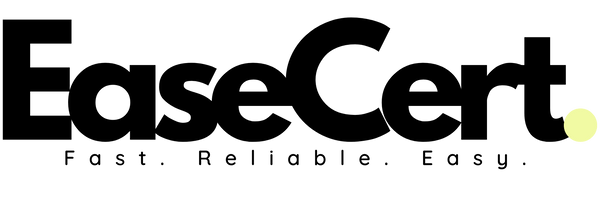
GPSR Risk Analysis & EU Product Safety Guide
Ensuring product safety under the General Product Safety Regulation (EU) 2023/988 (GPSR) is a legal obligation for all manufacturers, importers, and distributors placing consumer products on the European market. A structured GPSR risk assessment helps businesses systematically identify product hazards, evaluate compliance gaps, and implement corrective actions to meet EU safety and traceability standards.
The EaseCert GPSR Risk Analysis Template provides a step-by-step framework to document compliance evidence, map hazard categories, and ensure that all requirements under Articles 6, 9 and 19 of the GPSR are fulfilled. It supports economic operators in reducing the risk of product recalls, safety incidents, and enforcement penalties.
Download the GPSR Risk Analysis Template (PDF) to standardize your product safety evaluations and strengthen your compliance documentation.
Key Sections of a GPSR-Compliant Risk Assessment
Section 1 – Economic Operator Information
This section identifies all economic operators involved in the product’s supply chain (manufacturer, importer, authorised representative, and responsible person). Clear documentation ensures accountability and enables traceability as required under GPSR Article 9.
- Manufacturer – Full legal name, trade name, postal and electronic address, telephone number, and contact person.
- Authorised Representative – Mandatory for non-EU manufacturers.
- Importer – Required for traceability and verification of conformity documentation.
- Responsible Person (EU RP) – Designated EU contact legally accountable for product safety compliance. See EU Responsible Person Guide.
Under the General Product Safety Regulation (EU) 2023/988, the term manufacturer is defined broadly and is not limited to companies that physically produce goods. A manufacturer is considered to be any economic operator who:
- The business entity that places a product on the EU market under its own name or trademark, or designs and manufactures a product itself.
- Holds full responsibility for ensuring that the product is safe, complies with all applicable EU legislation, and is supported by complete technical documentation, a formal risk assessment, and conformity markings.
- Is deemed the legal manufacturer even if production is subcontracted or outsourced to another facility. If your brand name appears on the product, you are the manufacturer under EU law.
In short, under the GPSR, your company qualifies as the manufacturer because you are the one placing the products on the EU market. You remain legally responsible for product safety and compliance, even when an EU Responsible Person acts as your appointed contact within the European Union.
Section 2 – General Product Description
Defines the product’s characteristics, function, and intended use. It establishes the factual basis for hazard identification and risk assessment under GPSR Article 6.
- Product Name & Function – Describe intended use, product type, and consumer interaction points.
- Essential Safety Characteristics – List safety-relevant features (mechanical strength, electrical insulation, flame retardancy, etc.).
- Composition / Materials – Include main materials, subcomponents, and their compliance with REACH, RoHS, and POP Regulations.
- Age Grading – Identify target user age group per EN 71-1 or ISO 8124; see EU Age Grading Guide.
Section 3 – Applicable Legal Requirements & Standards
This section lists the legislation and standards applied to ensure compliance and demonstrate conformity within the technical file:
- Regulation (EU) 2023/988 – GPSR – General safety requirements and traceability obligations.
- Regulation (EC) 1907/2006 – REACH – Restrictions on hazardous substances and SVHC management.
- Regulation (EU) 2019/1021 – POP – Restrictions on persistent organic pollutants.
- RoHS Directive 2011/65/EU – Restriction of hazardous substances in electrical equipment.
- EN and ISO Standards – Include all harmonised standards relevant to product type (e.g. EN 71 for toys, EN 60335 for household appliances).
Section 4 – Product Design Evaluation
Each product design is evaluated against key hazard categories using physical inspection, testing, and supplier documentation. This ensures that risks are controlled to acceptable levels.
- Physical & Mechanical Hazards – Sharp edges, choking, entrapment (EN 71-1 / ISO 8124).
- Flammability & Thermal Hazards – Material ignition resistance (EN 71-2, EN 60335-1 Annex E).
- Chemical Hazards – Compliance with REACH and RoHS restrictions.
- Electrical Hazards – Insulation, grounding, and LVD requirements (EN 60335-1, 2014/35/EU).
- Hygiene Hazards – Bacterial contamination controls (ISO 22196).
- Radiation / EMF Hazards – Optical and electromagnetic exposure limits (EN 62471, EN 62233).
Section 5 – Risk Analysis and Assessment Findings
All identified hazards are categorised according to severity and likelihood following ISO 12100 and GPSR Annex I principles. Each hazard includes mitigation measures and label warnings where required.
- Critical Risk – Immediate corrective action required (e.g. suffocation, electrical shock).
- Major Risk – Design or manufacturing modification needed.
- Minor Risk – Resolved through warning labels or user instructions.
- Manufacturing Concerns – Controlled via quality assurance (ISO 9001 processes).
Section 6 – Labelling Requirements
Proper labelling ensures consumer awareness, traceability, and compliance with Articles 9 and 19 of the GPSR.
- Mandatory Information – Manufacturer and importer details, product identification, and batch number.
- EU Responsible Person – Include name, address, and electronic contact as shown on the template.
- Online Sales Requirements – Pre-purchase visibility of safety warnings in the language of sale.
- Markings & Symbols – CE marking, WEEE, LUCID ID, country of origin.
-
Product Warnings – Examples per EaseCert guide:
- ⚠ WARNING: Plastic bag can cause suffocation. Keep away from babies and children.
- ⚠ WARNING: Contains small parts – choking hazard. Keep away from children under 3 years old.
- ⚠ WARNING: Keep cords and straps away from children – strangulation hazard.
- ⚠ WARNING: Keep away from open flames and heat sources.
Why Use a GPSR Risk Assessment Template?
Using a structured framework ensures consistency, completeness, and efficiency in your compliance process. The EaseCert template aligns with Annex I of the GPSR and ISO 12100 risk assessment principles to provide:
- Systematic identification of all relevant hazards and testing requirements.
- Evidence-based risk mitigation and traceability documentation.
- Improved consumer safety and market acceptance across the EU.
- Reduced risk of recalls and regulatory penalties.
Get Expert Guidance on GPSR Compliance
At EaseCert, we help businesses achieve full EU compliance under the General Product Safety Regulation. Our specialists prepare risk assessments, technical files, and labelling documentation tailored to each product type. Contact us for expert support on GPSR risk analysis, EU Responsible Person representation, and GPSR certification solutions.
Frequently Asked Questions
What is a GPSR Risk Assessment and why is it required?
A GPSR risk assessment is a structured evaluation of potential product hazards under the General Product Safety Regulation (EU) 2023/988. It ensures that products placed on the EU market meet the general safety requirement set out in Article 5 and that foreseeable risks are mitigated through design, testing, and labeling. Every manufacturer and importer must maintain a documented risk analysis as part of their technical file.
Who is responsible for preparing the GPSR Risk Assessment?
The manufacturer or the designated EU Responsible Person is responsible for compiling and maintaining the risk assessment. Importers and distributors must verify that the assessment exists and that corrective measures are implemented before the product enters the EU market.
How detailed should a GPSR risk analysis be?
The level of detail should be proportional to the product’s complexity and risk. Simple items such as textiles or stationery may require a concise analysis, while electrical or children’s products demand extensive hazard evaluation covering physical, chemical, and electrical safety tests. EaseCert’s GPSR Risk Analysis Template ensures consistency across all categories and aligns with ISO 12100 methodology.
Is the GPSR Risk Assessment part of the Technical File?
Yes. The risk assessment forms a core part of the GPSR Technical File, which also includes supplier declarations, test reports, labeling proofs, and the EU Declaration of Conformity. Authorities may request this file at any time to verify compliance.
What happens if a company does not complete a GPSR risk analysis?
Failure to perform a compliant risk assessment may lead to product withdrawal, fines, or EU Safety Gate (RAPEX) alerts. Under Articles 35–38 of the GPSR, market surveillance authorities can require documentation or impose penalties for non-compliance. A verified risk analysis minimizes these risks and provides traceability evidence.
Can digital records or QR codes replace physical labels?
No. Digital information (QR codes or online manuals) can supplement labeling but cannot replace mandatory printed traceability information such as manufacturer details, batch numbers, or warnings. See EaseCert’s Labelling Requirements for GPSR Compliance for detailed guidance.
Do non-EU manufacturers need an EU Responsible Person?
Yes. Every non-EU manufacturer must appoint a legally established EU Responsible Person (RP) to act as the compliance contact under Article 16 of the GPSR. The RP’s name, postal address, and electronic contact must appear on the product or packaging. Learn more about appointment requirements in EaseCert’s RP Guide.
How often should the risk assessment be updated?
It should be reviewed and updated whenever there is a product modification, material change, supplier switch, or regulatory update. Routine annual reviews are recommended to ensure continued compliance and accurate documentation within the technical file.
Where can I get professional support with GPSR compliance?
EaseCert provides complete GPSR compliance solutions, including risk assessments, multilingual labeling, technical documentation, and EU Responsible Person representation. For tailored assistance, visit our Contact page or explore our GPSR Certification Packages.
Additional Resources
For further reading and official EU reference materials on product safety and compliance, consult the following sources:

